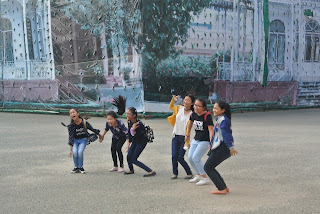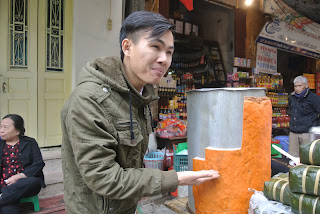As we are ready to leave Vietnam for Cambodia, we discussed our impressions of the country. As with any developing country that we have visited there are multiple perspectives on life in Vietnam. If it is viewed from a US perspective, it is a poor country of many people with underdeveloped infrastructure, and all that results from that situation. It doesn't look like the US. If you try and view it from a Vietnamese perspective, we realize we would have to be here for months before we can see life as the Vietnamese see it. So we have no insight to offer in this regard. We realize we looked at it from a position of watching and not understanding but enjoying it. All we read didn't prepare us for how rich and complex Vietnam really is. To some it up we totally enjoyed it and have very positive feelings about the country and the people.
It is 91 million people with an average monthly disposable income of $250 enjoying one of the longest periods in their history without war. Children are growing up never having known a conflict with the Chinese, French, Americans, or Cambodians. The country moved from a communistic economy where a family got bowls of rice and one egg a month to a free market economy in the mid 1980's where now people have enough food. It is a rice, vegetable and meat or fish diet, with noodle soup of Pho as the national dish. The food is complex and delicious with many different spices that vary according to region. We eat at a number of special restaurants where enterprising chefs are investing and creating interesting cuisine. These people are capturing the tourist dollar which is expanding each year.
As with most developing countries, labor is inexpensive so many things are done with manual labor that would be done with automation in the developed world. Development projects are looked on favorably since they bring higher paying jobs. Most Vietnamese want to accumulate money to start their own business, be it a shop selling almost anything. The cost of development is much less valued than in the developed world as most people are concerned about moving beyond subsistence levels of income and the downside of development is distributed to all.
Vietnam has a national hero in Ho Chi Minh or Uncle Ho as he is referred to. He was above all a nationalist with a single vision of an independent and united Vietnam and he pursued this dream his whole life. He adopted the communist philosophy, but was always willing to be pragmatic to gain the independent united Vietnam.

The Vietnamese are very superstitious and often rely on fortune tellers to advise them of decisions. An example is the beginning of anything seems excessively important to many Vietnamese. To many superstitious street vendors, the success of their day is determined by how it starts and by their first customer. When you are the first person to come by their cart and you do not buy anything, they might consider you a harbinger of bad luck. To redeem it, they would burn a piece of paper and wave or hop over it nine times, as to clear the air and burn out all hovering, ill-fated karma. There are other practices that can ensure good luck as well, such as scattering rice grains and salt.
Transportation has been transformed from human power with the motor scooter, which provides more independence in where people live. Given the importance of family in Vietnam with typically 3 generations living in the same house, plus unmarried siblings, people tend to stay near where they were born.
It appears that in many families the women work much harder than the men. Many hold jobs outside the home, but still do the morning household work and arrive home after work and shopping to prepare the evening meals. The husband we are told often has beer with his buddies and comes home later. There are exceptions to this where the work is equally shared.
Visually Vietnam is amazing in its diversity of landscapes. If you want to find the consequence of human life like trash, cell towers, electric lines, etc; that is here to see. The developing world is always under construction and you see it all over Vietnam. Get some money and do a bit more and repeat the cycle until the home is completed many years later.

It appears to be a very peaceful country with very nice people that are working hard to improve their lives and that of their children. We don't mean to paint a fairy tale, and maybe its the basic Buddhist nature of the country; but we thoroughly enjoyed our time here and the people we met.
To circle back to our opening comments, we have gained this perspective by watching and talking to people, our local guides in each of the areas we visited were very open and talked about their lives.
\

















































